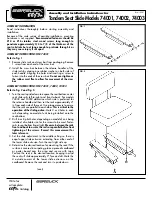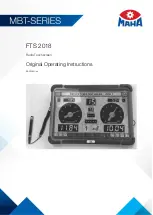
Modification
Date Vis.:
Type:
EMMOD201
Nr.:
17 / 26
gez.:
26.11.02 RR
27.02.09 RR
Description:
Interface definition EMMOD201 V2.0
Zeichnr.:
W2414e
6.2 Setting / resetting meters
Meters can be independently set to zero or all at the same time. They may be set to any desired content as well. This way you
can take over existing meter contents for newly installed devices.
Resetting
To reset meters for each value to reset the appropriate bit in the register must be set.
Register
address
Bit
No tariff switching
Tariff switching activated
0
P
incoming
P
incoming
HT
1
-
P
incoming
LT
2
P
outgoing
P
outgoing
HT
3
-
P
outgoing
LT
4
Q
inductive / incoming
Q
inductive / incoming
HT
5
-
Q
inductive / incoming
LT
6
Q
capacitive / outgoing
Q
capacitive / outgoing
HT
420
7
-
Q
capacitive / outgoing
LT
The active reactive power meters for the A230 arise from the configuration in 'Disp_Mode' (see chapter 7).
Setting
The same registers will be used as for meter readings.
Register
address
No tariff switching
Tariff switching activated
300
P
incoming
P
incoming
HT
302
-
P
incoming
LT
304
P
outgoing
P
outgoing
HT
306
-
P
outgoing
LT
308
Q
inductive
Q
inductive
HT
310
-
Q
inductive
LT
312
Q
capacitive
Q
capacitive
HT
314
-
Q
capacitive
LT
The active reactive power meters for the A230 arise from the configuration in 'Disp_Mode' (see chapter 7).
Unit factor
(read only)
Register
address
No tariff switching
Tariff switching activated
320
Unit factor
x
All meter contents are unsigned 32-bit integer numbers (2 registers for each value). These values refer to the significant
numbers, which will be displayed on the display unit itself.
The unit factor is an unsigned 16-bit integer number. It is used to scale the meter contents to the appropriate physical unit and to
define the number of post decimal positions (see chapter 4.3). This factor is valid for all meter contents of a device and can't be
modified.










































